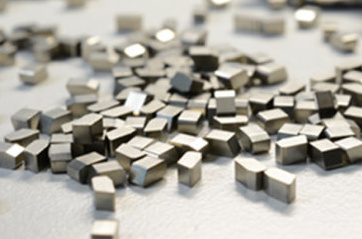はじめに
超硬チップソー は、様々な切削工具に不可欠な構成要素であり、その比類なき硬度と耐摩耗性で知られています。しかし、すべての超硬グレードが同じように作られているわけではありません。超硬合金のさまざまなグレードは、特定の切削要件を満たすように設計されており、それぞれが異なる用途に合わせた独自の特性を備えています。この包括的なガイドでは、鋸のチップに使用される様々な種類の超硬材種を調査し、その特徴的な特性を掘り下げて説明します。

超硬合金の組成を理解する
超硬合金は、炭化物粒子(通常は炭化タングステン)と結合剤金属(通常はコバルト)から成る複合材料である。これらの成分の比率はさまざまで、その結果、独自の物理的・機械的特性を持つさまざまなカーバイド・グレードが生まれます。
主要コンポーネント
- 炭化タングステン(WC):硬度と耐摩耗性を提供。
- コバルト:バインダーとして働き、強靭性と耐衝撃性を提供する。
超硬合金の種類
超硬合金は通常、その組成と用途によって分類されます。ここでは、最も一般的な種類をいくつか紹介する:
1.微粒超硬合金
微粒超硬合金は、通常1ミクロン以下の極めて微細な超硬粒子を特徴としています。この材種は、高い硬度と靭性を兼ね備えており、精密切削用途に適しています。
- プロパティ:高硬度、優れた刃先保持力、適度な靭性。
- アプリケーション:精密切削、木工、非鉄金属加工。
2.亜微粒炭化物
サブマイクログレイン超硬は、マイクログレインよりもさらに微細な超硬粒子を有し、通常0.5ミクロン以下です。この材種は卓越した硬度と耐摩耗性を持ち、高精度で高速の切削加工に最適です。
- プロパティ:優れた硬度、優れた耐摩耗性、高い刃先安定性。
- アプリケーション:高速切断、精密機械加工、仕上げ作業。
3.中粒超硬合金
中粒カーバイドは、カーバイド粒子が大きく、通常1~5ミクロンです。この材種は、硬度と靭性のバランスが取れており、幅広い切削作業に適しています。
- プロパティ:良好な硬度、バランスのとれた靭性、多彩なパフォーマンス。
- アプリケーション:汎用切削、木工、金属加工。
4.粗粒超硬合金
粗粒カーバイドは、通常5ミクロン以上の大きなカーバイド粒子で構成されています。この材種は、硬度よりも靭性を重視しており、耐衝撃性が重要な重切削用途に適しています。
- プロパティ:高い靭性、良好な耐衝撃性、適度な硬度。
- アプリケーション:重切削、粗加工、強い衝撃力を伴う用途。
5.超微粒子カーバイド
超微粒子カーバイドは、0.2ミクロン以下の極めて小さなカーバイド粒子を特徴としています。このプレミアムグレードは、比類のない硬度と切れ味を提供し、最も要求の厳しい切削作業に最適です。
- プロパティ:最高の硬度、優れた切れ味、優れた耐摩耗性。
- アプリケーション:超精密切断、微細加工、高性能アプリケーション。
超硬合金の比較
これらの超硬材種の違いをよりよく理解するために、それぞれの特性と代表的な用途を表で比較してみましょう。
| 超硬グレード | 粒子径 | 硬度 | タフネス | 耐摩耗性 | 代表的なアプリケーション |
|---|---|---|---|---|---|
| マイクログレイン | <1ミクロン | 高い | 中程度 | 高い | 精密切断、木工、非鉄金属 |
| サブ・マイクログレイン | <0.5ミクロン | スーペリア | 中程度 | 素晴らしい | 高速切断、精密加工、仕上げ |
| ミディアム・グレイン | 1~5ミクロン | グッド | グッド | グッド | 汎用切削、木工、金属加工 |
| 粗目 | > 5ミクロン | 中程度 | 高い | 中程度 | 重切削、粗加工、高い衝撃力 |
| ウルトラファイングレイン | <0.2ミクロン | 最大 | 中程度 | スーペリア | 超精密切断、微細加工、高性能アプリケーション |
説明:この表は、さまざまな超硬材種の主な特性を示しており、特定の切削ニーズに適した材種を選択する際に役立つ明確な比較表を提供します。
バインダー・コンテンツの役割
超硬合金のバインダー含有量は、その特性に大きく影響する。コバルト含有量が高いほど靭性と耐衝撃性が向上し、コバルト含有量が低いほど硬度と耐摩耗性が向上する。
高いバインダー含量
- プロパティ:靭性向上、耐衝撃性向上、低硬度化。
- アプリケーション:重切削、粗加工、強い衝撃力を伴う用途。
低バインダー含量
- プロパティ:硬度が高く、耐摩耗性に優れ、靭性が低い。
- アプリケーション:精密切削加工、高速機械加工、仕上げ加工。
超硬合金の革新
最近の超硬技術の進歩により、特性が向上した革新的なグレードが開発されている。ここでは、注目すべき技術革新をいくつか紹介する:
1.ナノ構造カーバイド
ナノ構造カーバイドは、ナノメータースケールのカーバイド粒子を特徴としています。この先端グレードは、卓越した硬度、靭性、耐摩耗性を備え、高性能切削用途に適しています。
- プロパティ:卓越した硬度、優れた靭性、優れた耐摩耗性。
- アプリケーション:高性能切削、精密機械加工、航空宇宙、自動車産業。
2.グラディエントカーバイド
勾配超硬合金は、表面から芯部にかけて組成が徐々に変化する勾配構造で構成されています。この設計により、表面硬度と芯部靭性の両方が向上し、耐摩耗性と衝撃強度のバランスを実現します。
- プロパティ:高い表面硬度、強靭なコア、優れた耐摩耗性。
- アプリケーション:金属加工や鉱業など、要求の厳しい用途向けの切削工具。
3.コーティング超硬合金
コーティングカーバイドは、カーバイド基材に高度なコーティングを施し、その特性をさらに向上させるものである。一般的なコーティングには、窒化チタン(TiN)、炭窒化チタン(TiCN)、ダイヤモンドライクカーボン(DLC)などがあります。
- プロパティ:硬度向上、摩擦低減、耐摩耗性向上。
- アプリケーション:高速切断、精密加工、研磨材の切断。
超硬合金の実用例
さまざまな超硬材種は、さまざまな切削用途に最適化されています。以下はその実例です:
1.木工
- 微粒超硬合金:精密切断や木工に最適で、シャープなエッジと優れた耐摩耗性を提供する。
- 中粒超硬合金:硬さと靭性のバランスが良く、一般的な木工に適している。
2.金属加工
- 亜微粒超硬合金:高速加工と仕上げ加工に最適で、高い硬度と耐摩耗性を提供。
- 粗粒超硬合金:重切削や粗加工に適し、高い靭性と耐衝撃性を持つ。
3.プラスチック切断
- 超微粒子カーバイド:プラスチックの超精密切断や微細加工に最適で、最高の硬度と切れ味を提供。
- 微粒超硬合金:一般的なプラスチック切断に適し、良好な刃先保持性と耐摩耗性を提供する。
4.建設
- 粗粒超硬合金:建築の重切削や粗加工に適し、高い靭性と耐衝撃性を持つ。
- グラディエントカーバイド:要求の厳しい切削用途に最適で、表面硬度と芯部靭性のバランスを提供。
関連コンテンツ
超硬製造における材料科学
超硬合金製造における材料科学の役割を理解することは、超硬合金グレードの性能と特性の最適化に役立ちます。さまざまな添加剤と結合剤が超硬合金の特性に与える影響を調べてください。
業界特有の設計上の考慮事項
超硬チップソーには、さまざまな業界で独自の要件があります。木工、金属加工、プラスチック切断、建築などの特定の用途に超硬材種を最適化する方法をご覧ください。
よくあるご質問
Q1:微小粒超硬合金と亜微小粒超硬合金の違いは何ですか?
A1: 微小粒超硬合金は、粒径が1ミクロン以下の超硬合金で、高い硬度と適度な靭性を備えています。サブマイクログレイン超硬合金は、粒子が0.5ミクロン以下とさらに細かく、優れた硬度と耐摩耗性を備え、高速切削や精密切削に最適です。
Q2: バインダーの含有量は超硬合金の特性にどのような影響を与えますか?
A2: バインダー含有量が高いほど、靭性と耐衝撃性は向上するが、硬度と耐摩耗性は低下する。バインダーの含有量が低いと、硬度と耐摩耗性は向上するが、靭性は低下する。適切なバインダー含有量の選択は、特定の切削用途に依存する。
Q3: 超硬合金を使用する利点は何ですか?
A3: コーティングされた超硬材種は、硬度を高め、摩擦を低減し、耐摩耗性を向上させます。窒化チタン(TiN)、炭窒化チタン(TiCN)、ダイヤモンドライクカーボン(DLC)などの一般的なコーティングは、工具の寿命を延ばし、特に高速用途や研磨用途での切削性能を向上させます。
Q4: 粗粒超硬合金はどのような切削用途に最適ですか?
A4: 粗粒カーバイドは、カーバイド粒子が大きく、高い靭性と耐衝撃性を備えているため、重切削、粗加工、強い衝撃力を伴う用途に適しています。堅牢な切削作用を必要とする建設および金属加工作業に最適です。
Q5: 超硬合金はどのように切削性能を向上させるのですか?
A5: ナノ構造カーバイド材種は、ナノメータースケールのカーバイド粒子を特徴とし、卓越した硬度、靭性、耐摩耗性を提供します。これらの高度な材種は、航空宇宙産業や自動車産業における精密加工を含む、高性能切削用途に適しています。
超硬チップソーを安く買いたいですか?クリックしてください これ.




